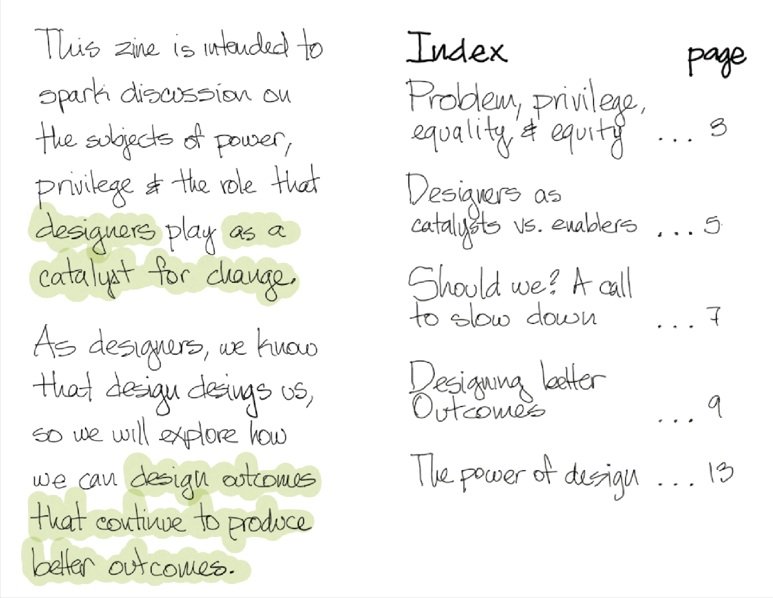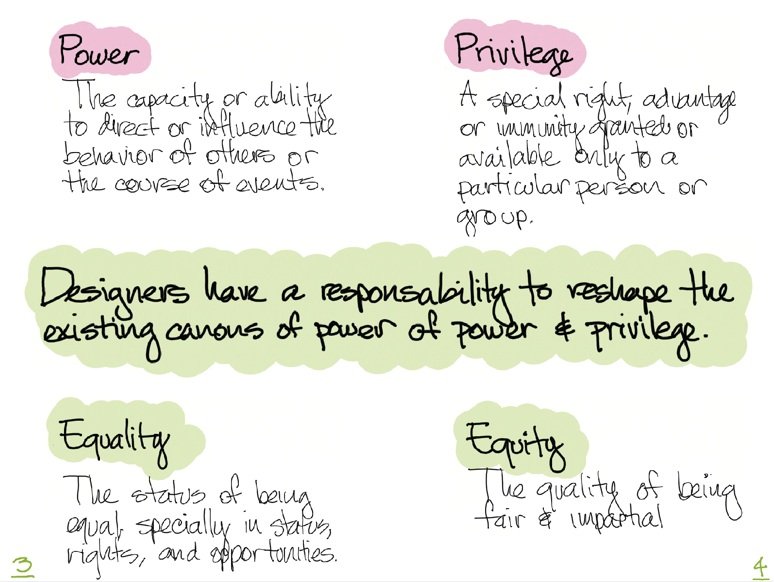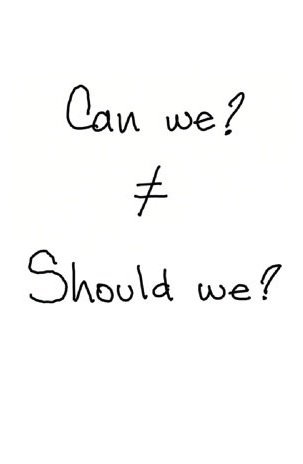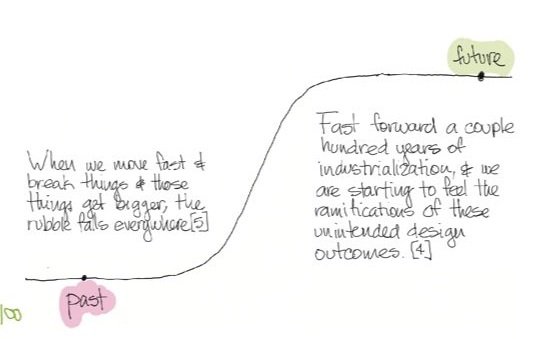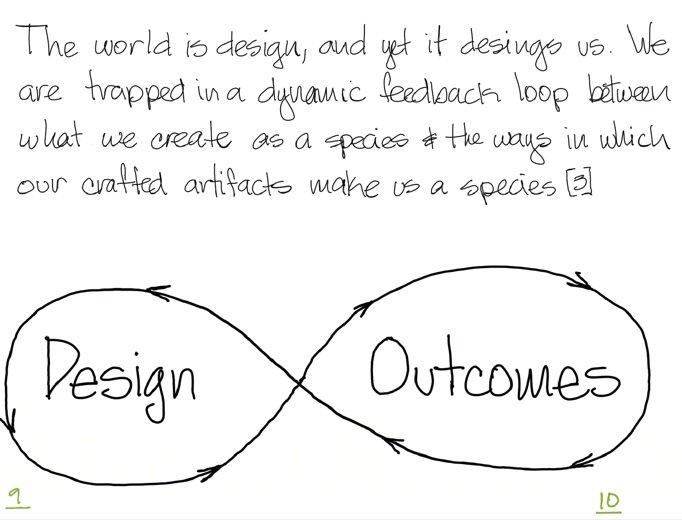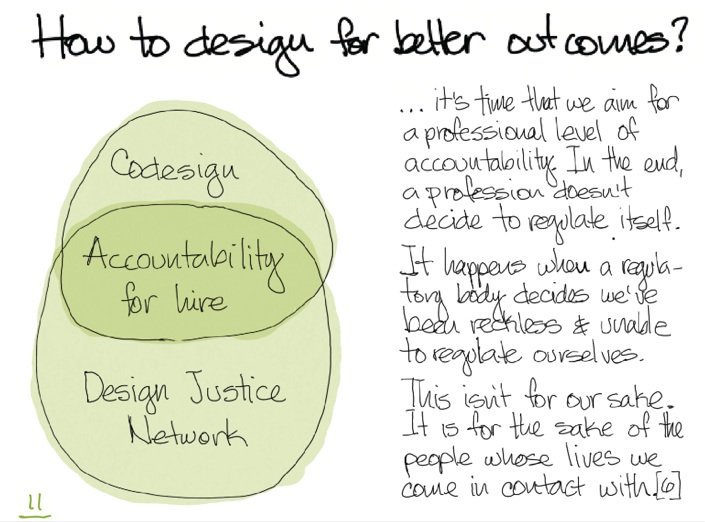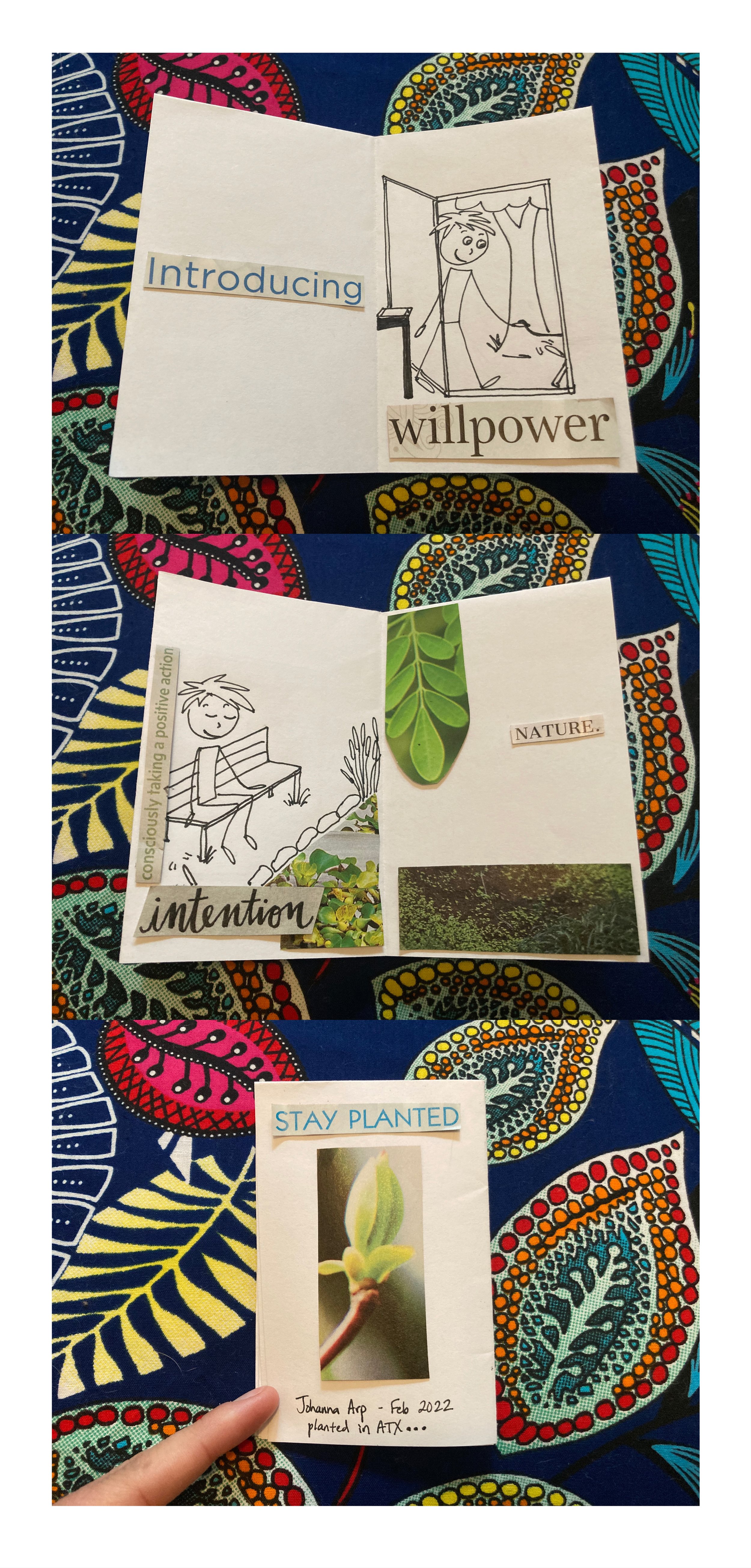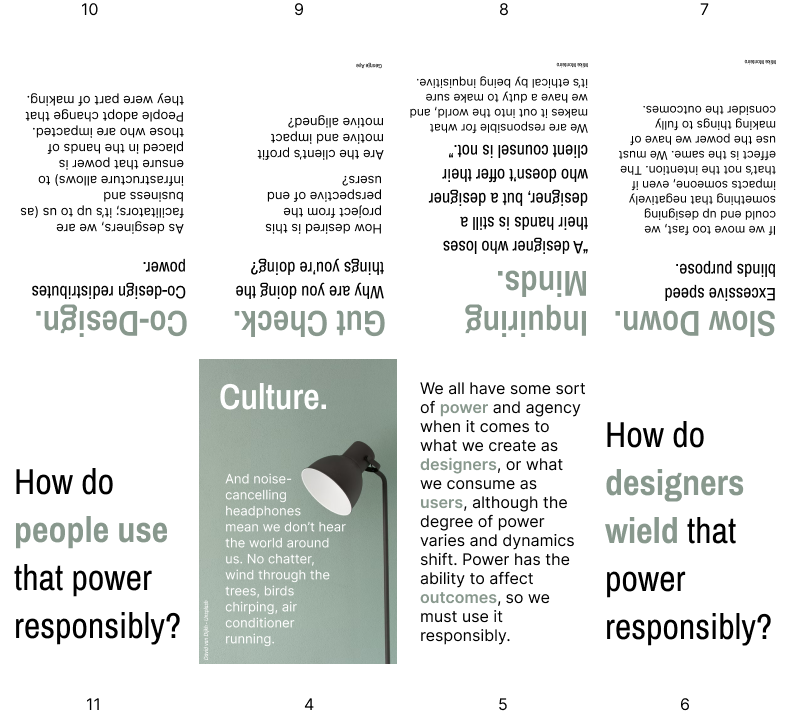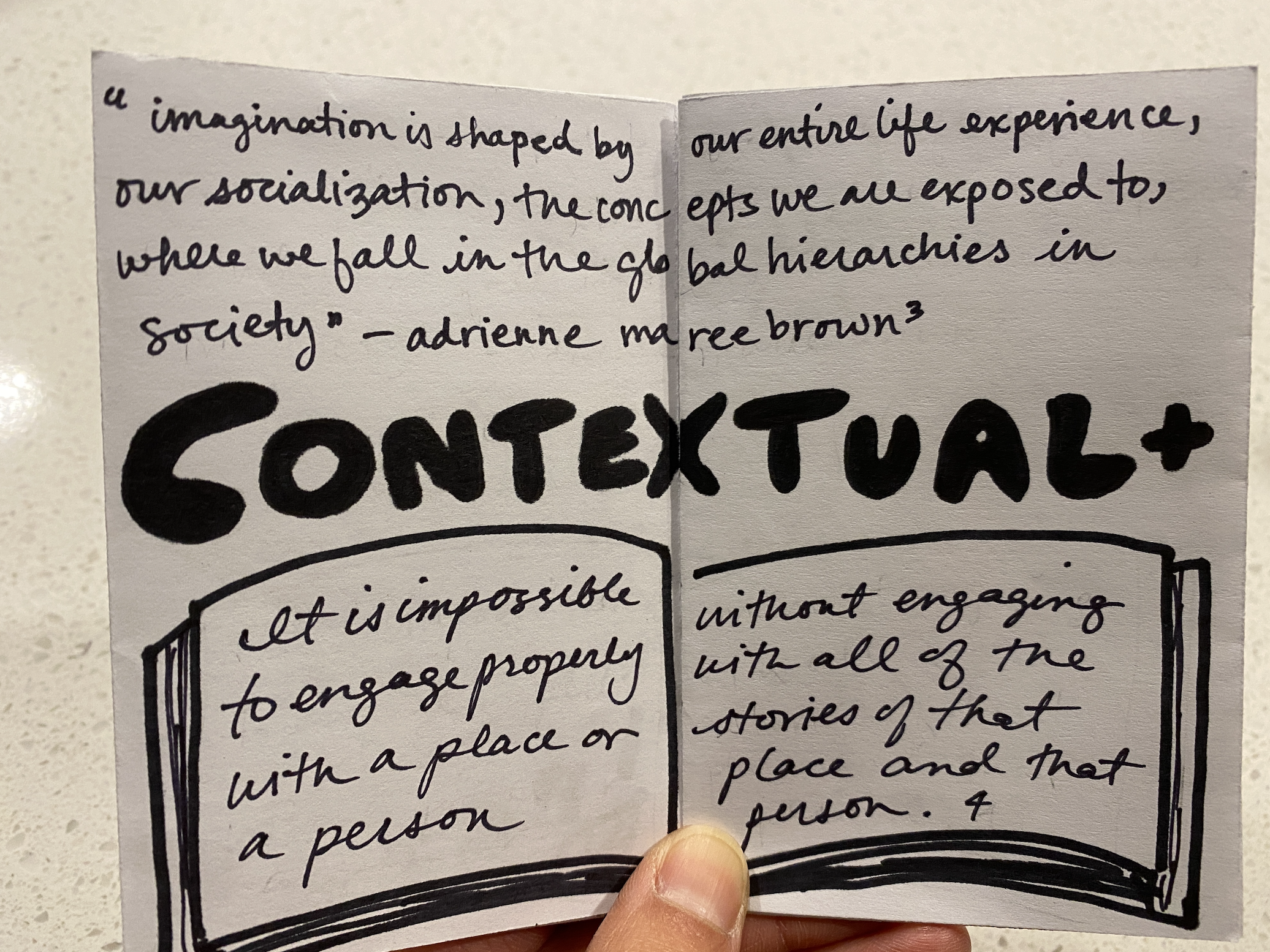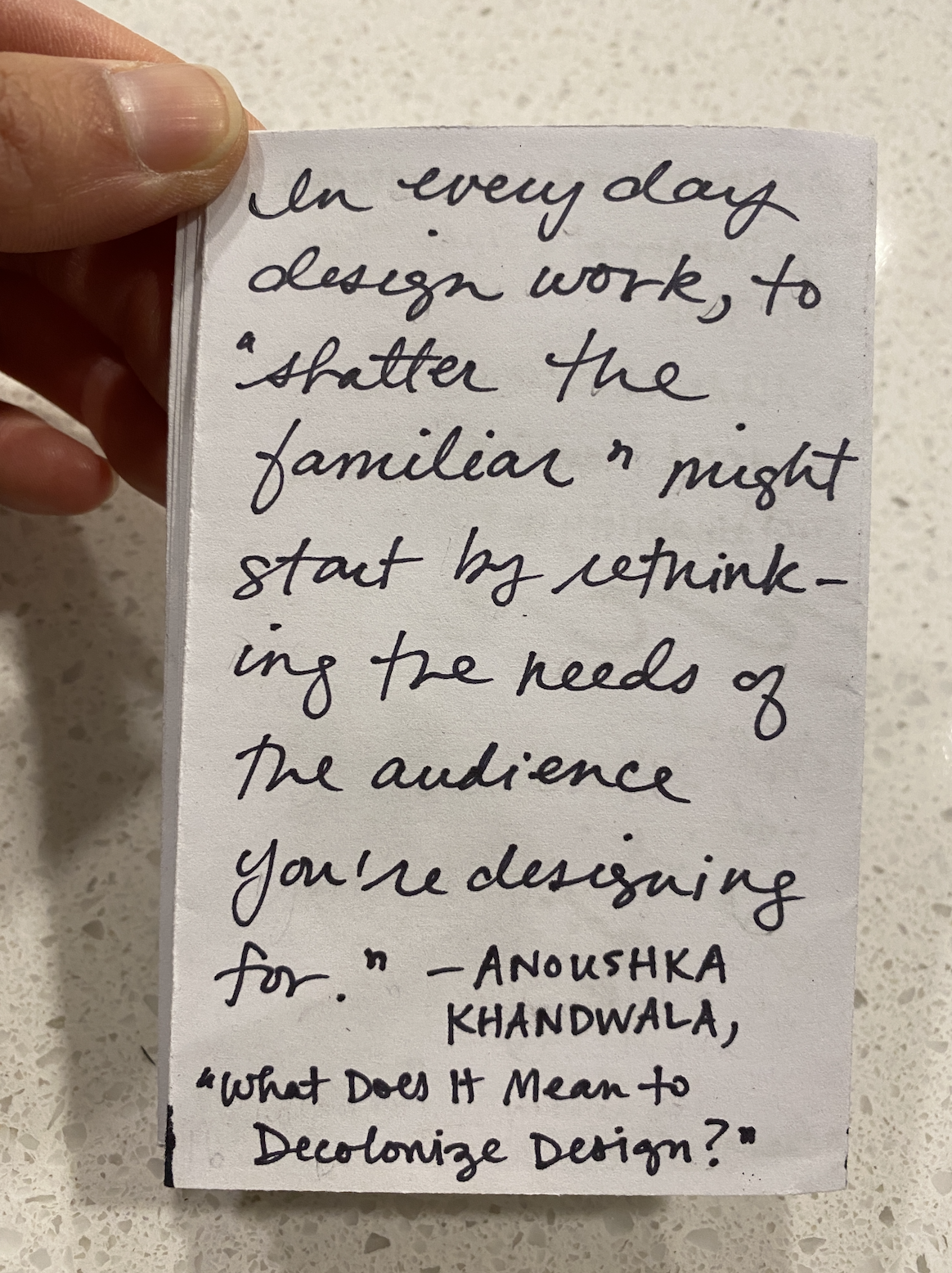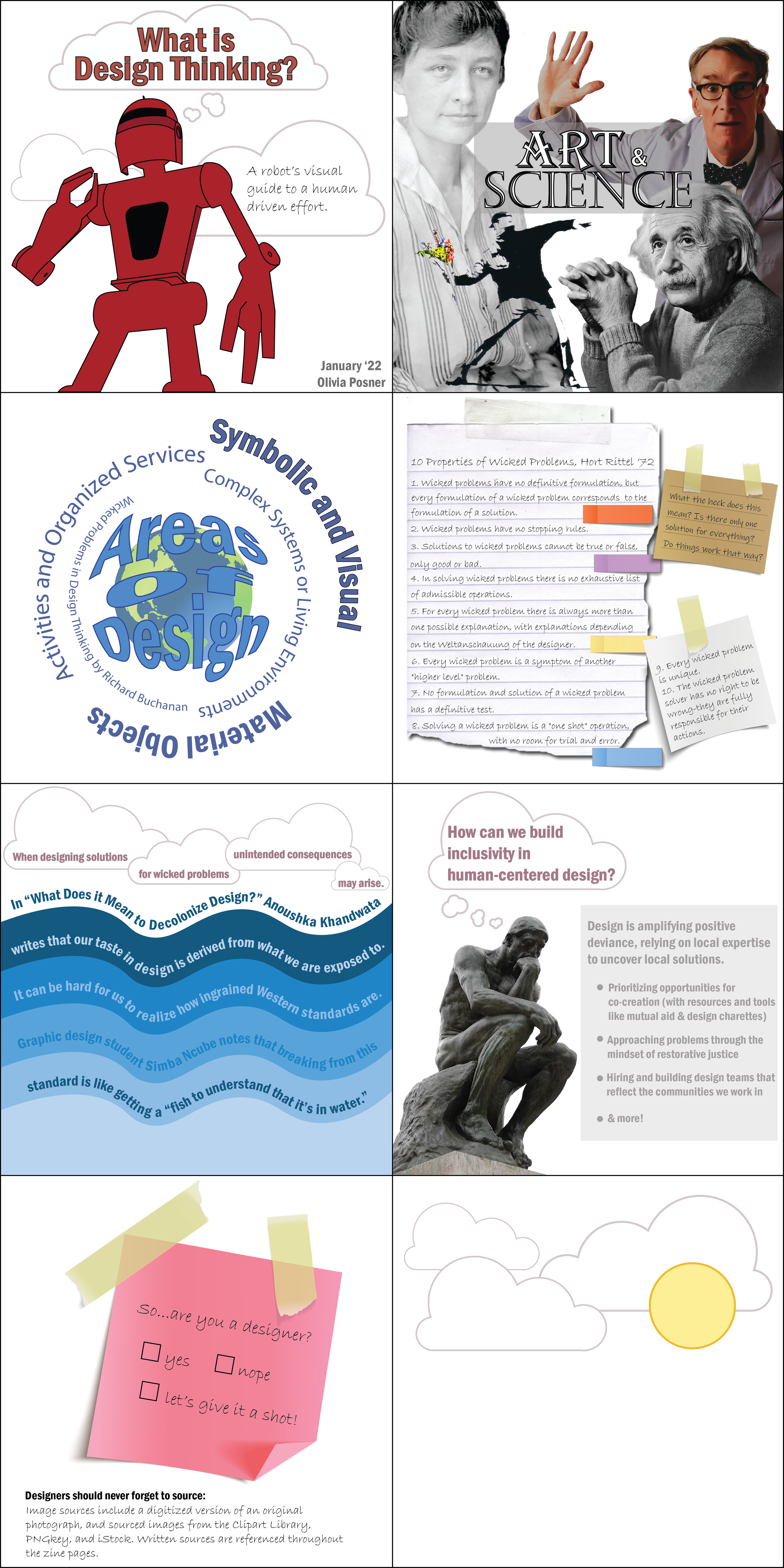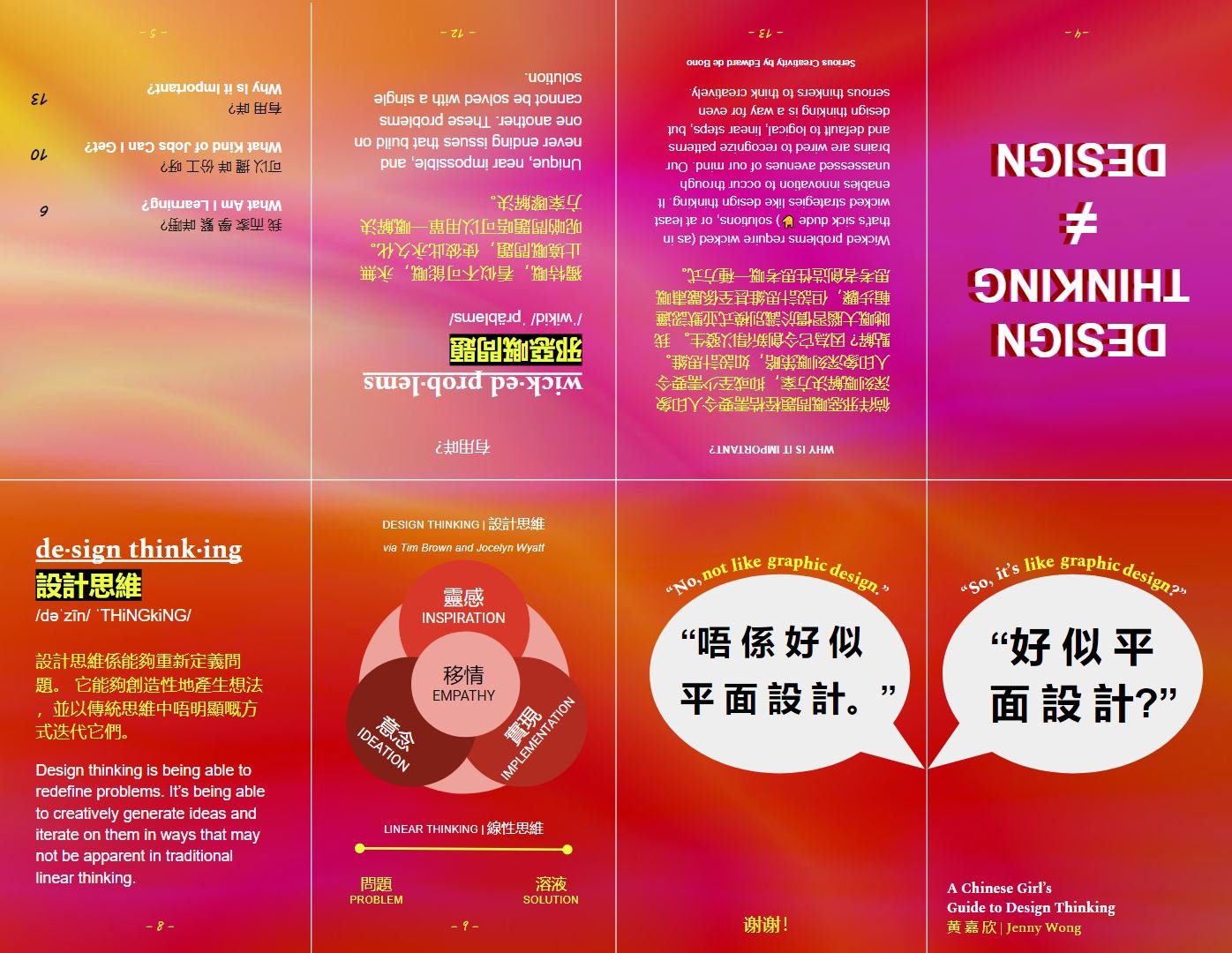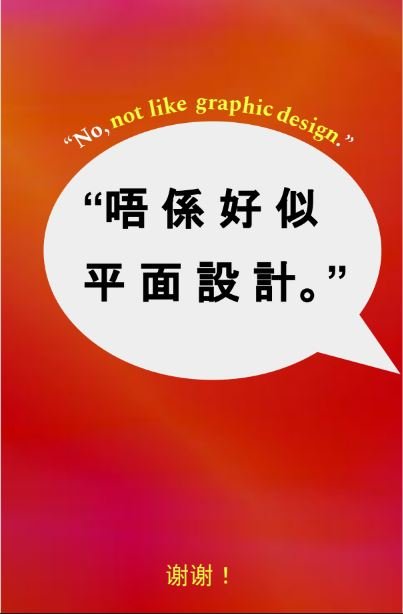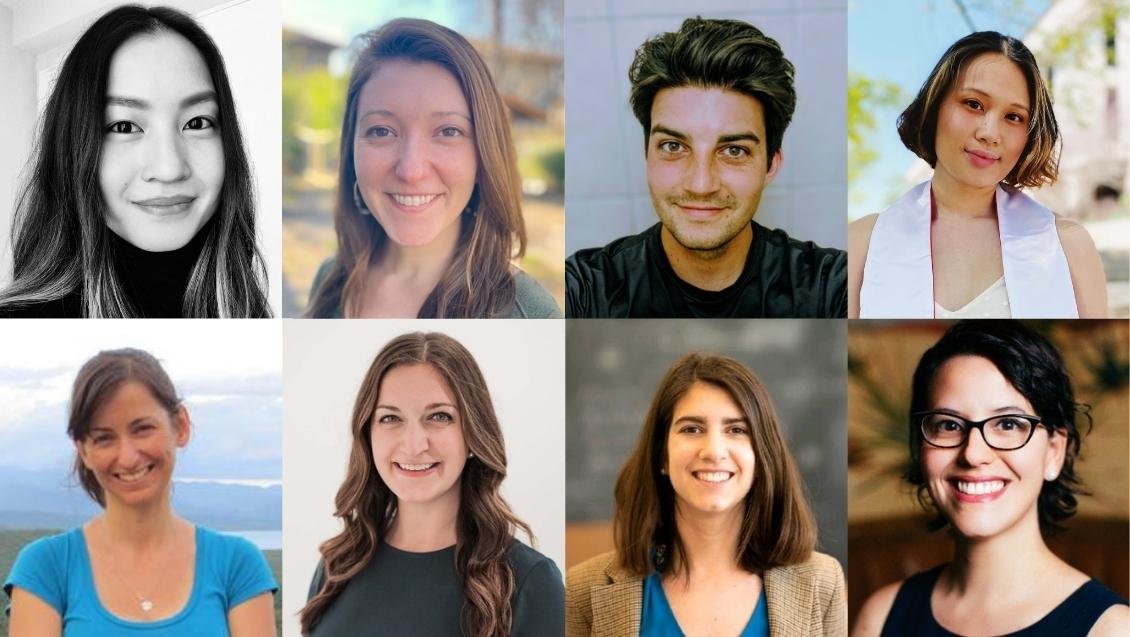Technology, Design, & Social Responsibility
Over the past few weeks, in Theory class, we have discussed the topic of technology, design, privilege, and power. Designers have more power than they generally claim. It is time for designers to take responsibility for their power and use it as a catalyst to elevate people/users and communities.
In the context of technology, the conversation is always about “How fast can we deliver this new feature. What will the return on investment?” Of course, those are great questions that need answers. However, revenue questions should not replace questions about “What will be the implication of this solution? or How benefits from this solution and who is marginalized?”
The industry is missing accountability. It has grown fast and wide. Designers are no longer on a corner, working on the next cool gadget or magazine cover. Today designers are in the public sector, technology, health. Poor solutions lead to poor outcomes, especially for the people/users and marginalized communities during the design/solution process.
I do not have any answers, but I hope that we can continue having this conversation with this zine. And one day, with our design powers combined, we can create accountability that leads to better outcomes for the people/users and communities we serve.
Re-orient
In her musings on how design designs us, Leyla Acaroglu calls design “…a silent social scripter that softly shifts and curates the values, opinions, cultures, and experiences of humans all over the world.” In this zine challenge, I wanted to explore the promises and power of technologies/companies/designers to bring us the world and remove us from the world we move in [and why]. There are many conversations about policy and systems that are vital for this moment. But I wanted to recall a simple and immediate tool of resistance present in our back pockets: the power to choose for ourselves how we will engage, re-orient, and navigate this. In her reflections on how to do nothing, Jenny Odell reminds us of the value of recharging. She shares a quote from David Abram that resonated strongly with me: “Only in regular contact with the tangible ground and sky can we learn how to orient and to navigate in the multiple dimensions that now claim us.” I concur.
For further reading:
https://medium.com/disruptive-design/how-design-designs-us-part-1-6583a9b61b57
https://medium.com/@the_jennitaur/how-to-do-nothing-57e100f59bbb
David Abram, The Spell of the Sensuous: Perception and Language in a More-Than-Human World
How do we use power responsibly?
Over the last two weeks, we engaged with articles and videos about design, technology, and power. As a class, we discussed how they connect and how as designers we can use that power responsibly. Power affects outcomes. We as designers tend to have more power, and that power can give more power to the people we’re trying to help, or if not used responsibly, can lead to very negative outcomes. We design technology to shape our culture, and in turn that shapes us and what we continue to design–so we must choose to slow down and check the “why” behind what we’re doing.
For my second zine, I decided to create it on Figma to practice my skills for upcoming projects.
I also created it to be a mini zine to test my spatial abilities: 2.75” x 4.25”
Please use the numbers as a guide to read the zine in order.
Zines: A Tool for Self-Expression
This was my first real zine (aside from our warm-up zine class activity), and I can see why people love them. Zines allows for self-expression and FUN. As someone who rarely partakes in arts and crafts, I decided to go the digital route and made my zine in Canva. I wanted to focus on creating something that was fun to look at while also guiding the reader to want to learn more. I also wanted the message of the zine to end on an optimistic note regarding the future of design.
If I were to do this project again, I would challenge myself to create a zine by hand. At the start of this project, I was envisioning creating something that looked like a Dr. Bronner’s bottle of soap (if you know, you know), and I sort of wish I had followed through with that vision. Given the time constraints, creating something by hand would have allowed me to focus on the message I wanted to convey rather than less important things like fonts, photos, and how to print the dang thing. All in all, though, this was a super interesting experience and I’m glad to know more about the zine world. ‘Til we meet again, zines!
What time is it? ZINE TIME!
Our first deliverable after 2 weeks of participating in our Q1 Public Sector, Innovation, and Impact course with instructor Christina Tran was to make our own zine – HOW. FUN.
The prompt was: What is design (thinking), and why should (or shouldn’t) we use it to tackle wicked problems?
Do I prefer this to writing a paper? Heck yes.
I like going analog, because my hands are doing more than just typing. It stimulates my brain in a different way, engaging in something more tactile as I’m processing and organizing information. By putting pen to paper, things feel exploratory, playful, and messy.
This is only the third zine I’ve ever made (second one being the zine we made to help introduce ourselves in the first session of this course, barely 2 weeks ago), but I can easily see this becoming a thing.
Need to get my creative juices flowing? Zine.
Mildly grieving the end of a great book, film, or TV show? Zine!
A friend’s birthday coming up, and we’re still stuck in this pandemic? ZINE.
Did I answer the prompt entirely? Maybe, maybe not. When I thought about what design was, I thought about what it meant to me, and how that interpretation had evolved.
I thought about past readings that have inspired and informed my ideas about design and its place in the world (as well as my relationship to it), such as adrienne maree brown’s “Emergent Strategy: Shaping Change, Changing Worlds”, in which she highlights the importance of connection, the 1:1 relationship, interdependence, adaptation, and challenging ourselves to reimagine what’s possible when we tune into the wisdom that nature affords us, inviting lessons from the principles and behaviors that exist in natural ecosystems. I integrated those learnings with work that we’ve recently been exploring and discussing in class, such as Anoushka Khandwala’s thoughts on what it means to decolonize design and Richard Buchanan’s “Wicked Problems in Design Thinking” (from 1992), in which he calls design thinking the “new liberal art of technological culture”.
Some common threads that surfaced for me were the importance of systems thinking (because we all exist and operate within different systems), learning to adapt alongside change (which is constant and inevitable) while maintaining compassion for ourselves and others, and challenging ourselves to envision new ways of being and creating – and then making that tangible somehow, by first putting new ways of being and creating into practice, one small (sometimes uncomfortable) step at a time.
So when it came to the zine, I wanted to express some of the words that were floating around in my mind; words I associated with how I’ve come to think about design, the principles that have influenced my approach (thus far) to designing, and the responsibility I feel that comes with designing products, systems, and services.
Of course, there’s only so much content a 3”x 5” zine can hold (part of the beauty of it!). There’s more to be said, and design is an ongoing conversation, so I welcome your reactions, questions, ideas, and provocations.
It was thrilling, it was fun, it was challenging… it was a tad bit rushed! It was inspired by others who have written things about design that resonated with me, and I hope this little zine, in some way, shape, or form, resonates or stirs something up in you.
…And here it is, my zine (hope you get a think/kick out of it!):
Design Thinkzine
My aim in this zine challenge was to distill the extensive topic of design thinking into the smallest format possible - pulling out what has resonated with me at this early point in my own design journey and finding my own words to communicate this to others.
To read more, check out:
1. Escobar, Arturo. Designs for the Pluriverse. Duke University Press, 2018.
2. Szczepanska, Jo. Design thinking origin story plus some of the people who made it all happen. https://szczpanks.medium.com/design-thinking-where-it-came-from-and-the-type-of-people-who-made-it-all-happen-dc3a05411e53
3. Buchanan, Richard. Wicked Problems in Design Thinking, Design Issues Vol 8, No 2, Spring 1992, The MIT Press.
4. Khandwala, Anoushka. What Does it Mean to Decolonize Design?: Dismantling design history 101. 5 June, 2019. AIGA Eye on Design. https://eyeondesign.aiga.org/what-does-it-mean-to-decolonize-design/#:post_81855
5. Design Justice Network Principles. https://designjustice.org/read-the-principles
6. Brown Tim & Wyatt, Jocelyn. Design Thinking for Social Innovation. Stanford Social Innovation Review, Winter 2010.
Design thinking for a world of wicked problems
Over the past two weeks, our class has discussed the ideas of who can call themselves a designer and what design is. A recurring topic discussed was that design does not exist in school curriculums until college.
Design thinking transcends the field of design. It is a methodology that everyone should learn in the early stages of education—not reserved for those who can attend college. I created the zine below for people with little to no knowledge of the methodology. I hope this zine sparks curiosity and a new angle to solve problems with humanity at the center.
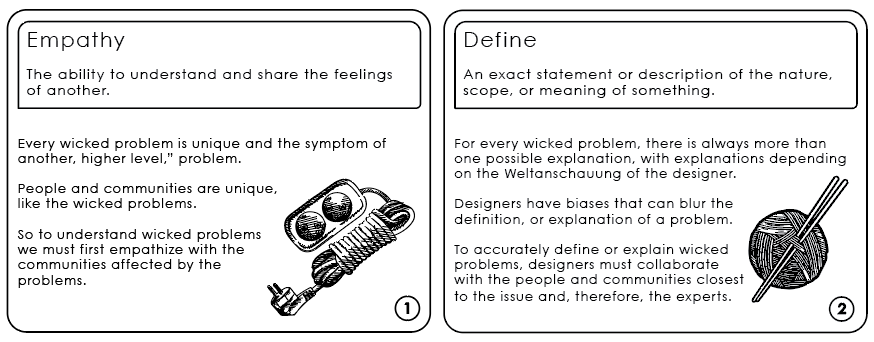
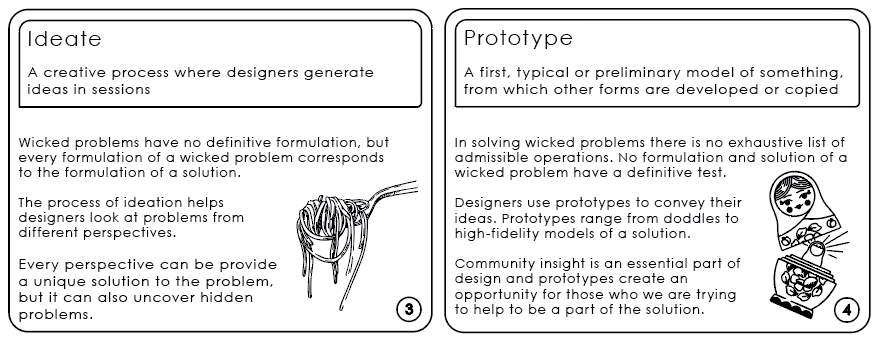

What is Design Thinking… the zine!?
Image to be read left to right, row by row.
Welcome! Please feel free to take a look at my very first AC4D creative deliverable…a zine that explores the topic, what is design thinking? In the first two weeks of our Theory class, we have been engaging with readings from authors that theorize human centered design, its capability to solve through co-creation, and its downfalls of unintended consequences and exclusivity.
My intended audience is anyone new to design thinking (hi!). I tried to capture the essence of some of the key theories we touched on in our initial reading, and best practices for inclusive design we learned about in modern readings. I wanted the reader to see the diversity in theory by seeing diversity in the ways the ideas were displayed (collage, word art, etc.) Let me know if you happen to think, “wow, design thinking looks like a field with a lot of diverse ways of communicating, and I want to learn more about it!” That’s what I was going for.
“So, It’s Like Graphic Design?” | “好 似 平 面 設 計?”
A Chinese Girl’s Guide to Design Thinking
I’m familiar with zines but have never made one myself, so I figured I might as well make one I can use on a daily basis. Design is hard enough for me to explain in English to friends and curious strangers on airplanes, so imagine me trying to do so in broken Cantonese to my parents. My dad calls me at least once a week, asking me to remind him what it is I’m trying to learn again. It’s both frustrating and shameful because Chinese is my first language, yet I’m not fluent enough to articulate these complex philosophies and thoughts. This is why “So, It’s Like Graphic Design?” was put into existence— so I can hopefully just mail one to my family members and they won’t have to ask me anymore. Feel free to print one out if you’d like by clicking on the link above. Click here for the video to teach you how to assemble the zine.
Most Chinese people read in Mandarin, but I unfortunately am not very confident in my Mandarin skills to go between English and Mandarin translations. To get some reasonable Cantonese translations, I used Microsoft Bing (because believe it or not, there aren’t many English to Cantonese translators out there). I can’t read in Cantonese at all really, so I relied on the text to speech function to listen to what was translated instead. My listening and comprehension skills are still lacking, but much better than reading or writing. I would also use speech to text, speaking in Cantonese, to get the correct characters if I felt like what was translated by the application was incorrect/felt awkward.
Honorable Mention: I was inspired by Clarence Kwan’s zine “Chinese Protest Recipes” that highlighted ways Asians Americans can support the Black Lives Matter movement while also sharing traditional Chinese recipes.
What the heck is design thinking?
As someone who is now taking my first “formal” dive into “what is design thinking,” I figured that many prospective AC4D students may not know what it is either. I created this zine to illustrate what design thinking is, and how it can be used to solve wicked problems.
Design Thinking Is…
Our assignment was to create a zine within the framework of this prompt. What is design (thinking), and why should (or shouldn’t) we use it to tackle wicked problems?
I wasn’t even sure how to make a zine, so I started there. After exploring popular formatting options, I came across the idea of folding the paper like an accordion from a zine review youtube video.
The questions of “what is design thinking” and “should we use it to tackle wicked problems” have been at the heart of our theory class for the past week, but I wanted to round out my opinion with supplemental writings. Doing secondary research on this history of design thinking, I came across Design thinking origin story plus some of the people who made it all happen by Jo Szczepanska.
The idea of creating a historical timeline of important innovations in design thinking immediately meshed with the accordion zine format. From there I was able to draft an outline of what would appear on each panel and then began designing.
Week 0 Musings
This week felt like a field trip to the beach. I got pushed by a few waves - of knowledge. I stumbled through sand - of confusion. The sun was warm and bright - like the students and professors. Now I am home, tired from all the adventure. Thinking about how much I loved it and how lucky I am to have found this brilliant and kind community.
The week went by fast. Every day, we learned a new design process and its relationship with previous processes. We learned about research interviews, synthesis, prototyping, and field testing. Below is a summary of my main takeaways.
Trust the Process: Situations will not always be explicit or within our control. However, we know steps and processes that help us move forward to gain clarity and confidence. We must trust that following those processes will lead us somewhere, even if it requires iterating.
Unlearning, to learn: I thought my experience as a recruiter would help during Design research. I was wrong. Researchers ask broad questions and listen, while recruiters tend to control interviews, looking for a wrong\right answer. So to become a better researcher, I have to unlearn being a recruiter.
Collaboration does not mean everything is a team activity: The purpose of collaboration is to work together to create. That does not mean doing the same thing at the same time or place. Teammates must learn each other’s styles and needs. Then give each other space to be themselves without the stigma of not being team players.
This is all for now. I cannot wait for class to start next week and do all of it again.
Hopping on the Learning Rollercoaster
When our cohort of eight started at AC4D this week, I didn’t really know what to expect. I knew the topics we’d be covering, and I knew I was excited – excited to learn things by doing, doing, doing (...and doing, doing, doing some more), meet people I could connect with and learn from, and challenge myself in new ways. As we wrap up our orientation, here are some things that I was reminded of this week:
Knowing what a growth mindset is, is entirely different than truly adopting one
Design is messy because real life is messy
Choose people over process when hitting roadblocks as a team
Practicing a Growth Mindset
Having been in the learning and development space for awhile, as well as playing the role of manager and coach in different jobs, I was pretty familiar with Carol Dweck’s concept of growth mindset. In short, growth mindset is the belief that our skills and behavior aren’t fixed, and that if we put something new into regular practice, we’ll eventually become better at it. Not super revolutionary when you think about it, but it’s way easier said than done.
Growth mindset influences how we deal with the challenges and discomfort that come with learning (especially as adults, when many of us tend to be a bit more resistant or stubborn about changing our existing habits), and therefore, how effective we are at picking up something new.
This week during orientation, we were put into small groups to experience a design process together, “thrown into the deep end” style – meaning, our facilitators took the design process that we’ll be practicing and refining during our time at AC4D and accelerated it, condensing it into five, jam-packed days.
Unsurprisingly, I found myself feeling scattered, rushed, uncomfortable, confused, and frustrated in different moments throughout the past week, especially when it came to understanding how my two teammates’ different ways of communicating and collaborating came into play. As we weren’t given a lot of time to get to know each other before working on our assignments together, this likely compounded some of the discomfort and frustration I experienced.
However, we’re more likely to learn and gain insight from experiences that elicit strong emotions from us, particularly when those experiences are painful, so reminding myself to maintain a growth mindset when things got a little challenging proved to be helpful. It was a great reminder to trust the process, do my best to exercise patience (with myself and others), and be open to what unfolds. It was also a great reminder that knowing what a concept like growth mindset is and how to describe it doesn’t necessarily mean we know how to demonstrate it – and that being willing to engage in practice is the most important part, because that’s when we can understand it best.
Messiness in Design Reflects the Messiness in Life
Going into AC4D, I was aware that design was messy. As we went through the different steps of the design process, that became even more apparent (and yes, at times annoying). While I’ve gotten fairly comfortable with adapting in new environments and navigating through ambiguity, that doesn’t mean I enjoy these things, especially in the moment. I’m constantly trying to make sense of what I’m experiencing, often seeking clarity (where there may be none), creating structure where I can, and wanting more time to process and connect the dots.
Diving into the design process with my fellow classmates, the “dots” weren’t always clear to us. I wondered whether this was by design (how meta!) or just inherently part of the process. There were moments when I felt like dots were missing entirely. As frustrating as this was at times, I compared the messiness I was experiencing to the messiness in the real world and reasoned that the process was simply mirroring what we all go through in our personal and professional lives. There are many ways to approach tackling the problems we’re faced with, and no matter what approach we take, the messiness is pretty inevitable. As designers, we’ll be designing things for real people with beautifully complex, nuanced stories and lives, so it’s no surprise that design is messy, because life is messy.
People > Process
This past week has also reinforced to me the value of simply listening to people’s experiences and stories in the design journey, and I don’t just mean the audiences I’m designing for. Design is rarely a solo adventure, and to me, a critical part of successfully designing a product, service, policy, or system is how effective I am at collaborating with others.
This is, of course, not unique to the field of design. Collaborating with others in our work and our jobs is just a part of the process. But how many of us genuinely invest in establishing some level of trust with those we work with, and how might a product (or service, policy, or system) end up even better if we gave greater thought and care into balancing building trust with our collaborators with the process of doing the work together?
I mentioned earlier that I experienced some discomfort this past week upon being thrown into new challenges with new people I hadn’t really gotten to know beforehand. There were times when I noticed my own frustration getting in the way of exercising patience with others, or when I was more focused on getting to the goal than inviting others to talk things through with me, and when this happened, I did my best to slow down and refocus my attention on the dynamics and energy within my group. Yes, it felt a little messy and uncomfortable, but in the end, we always arrived at a greater place of understanding and, I think (I hope!) trust. This is something I’m still working on, and will continue to work on beyond AC4D. In the meantime, I’m grateful to have the opportunity to do this with the seven other designers-in-training over the course of our program.
To sum it up, what the past week highlighted for me is that design doesn’t happen in a neat, straight line because our lives don’t happen that way. And when I’m experiencing tension, whether internal or external, connecting with people with intention will consistently bring me back to where I need to be – a place where empathy, creativity, and growth can thrive, despite being in the thick of a little chaos, confusion, and uncertainty.
Design Research 101
If there was one aspect of the AC4D program I was looking forward to most, it was getting a chance to implement the design research process. What is design research? It is learning from people in the context of their lives to obtain emotional insight, build narrative, and create value. In our AC4D orientation week, we focused on bite sized lessons followed by hours long working group sessions to build our own “fast and furious” attempt at design research. Here’s my understanding of the process paired with some insights gained from our directive: explore the topic of mental and physical health of frontline workers.
Step 1: Identify participants and develop a focus
In our respective groups, we gathered a list of frontline workers we know and love to talk with about their experiences. Our group consisted of healthcare workers (doctors, residency students, a dentist, a physician, a pharmaceutical worker, and a physical therapist) as well as a vaccine manufacturer. Our group brainstormed open-ended questions to develop a focus, which became we are researching how the relationships that frontline workers have (both in and outside of work) influence their physical and mental health.
Step 2: Create questions to gain insight on the research focus
Timed brainstorming sessions became the method of choice for our group this week. Developing a list of open-ended questions was a step that frankly deserved more time than we had to give. But when the theme of orientation is “fast and furious” – deliberation falls by the wayside. We decided to ask three key basic questions and developed a series of follow up questions in response. We wanted to understand a little about the following:
How healthcare workers spend their time (and wish they could spend their time) between shifts.
Who is important in their lives, and how work impacts their relationships with those people.
Who they work most closely with and how that relationship has changed with covid.
Step 3: Interview the research participants
In one afternoon, we interviewed eight participants back to back, pushing the limits of what a Sunday afternoon typically looks like. With one interviewer and one notetaker, we held short but meaningful conversations with these frontline workers. Our follow up questions managed to dig a little deeper, however we ran into a few instances where interviewees were asking us to clarify what we were looking for. However, I’m learning that designers are really working from a mindset of “no right answers,” so in order to get genuine “nuggets” of information from their participants, it is necessary to reassure them that whatever comes to mind is most helpful. Another trick we learned was to ask someone to tell us about a time when. For example, after asking “who is most important in their lives,” we asked the follow up, “tell me about the last time you spent time with them”. Overall, the value they provided helped us gain some valuable insights that we took to the next stage of our process.
Step 4: Synthesize insights based on interview “nuggets”
After reflecting on main themes from each interview and transcribing all interviews, we had a very large stack of printed “utterances” (or statements from our interviews). We learned a bit about pairing off statements with an “inferred likeness” and how to develop a connection statement - or what bonds those two statements. After separating many of our utterances, we were able to see several main themes develop. Some of ours included:
Participants long to be with family
Shared experiences sustain the healthcare workers we talked to
The toll of work can cause loss in relationships
Coworker relationships have become integral to their daily survival
From these insights, we could see some of the joyful and difficult aspects of the relationships that our healthcare workers sustained. We understood that in all cases, they relied heavily on several key people in their lives; and in some, that their co-workers had a shared understanding of working on the frontlines that was irreplaceable.
Step 5: Develop provocative insights based on your insights
The first piece of developing provocative statements was asking “why” following each insight. Then, zeroing in on a potential answer to that question, which can serve as a jumping off point for the next step in the process. The following questions were leveraged into (semi) provocative statements that allow us to begin to understand why our interviewees felt a certain way.
Why do participants long to be with family? They can be themselves and feel comfortable around family.
Why do shared experiences sustain the healthcare workers we talked to? They see some shit that the rest of us don’t understand because we don’t live and breathe it like they do.
Why does the toll of work cause loss in relationships? It is painful to lose a piece of yourself when giving an inordinate amount to your job.
Why have coworker relationships have become integral to their daily survival? Coworkers are a part of the team and help shoulder the burden.
Step 6: Develop many ideas that can address your provocative statements
At this stage, we had a lot of great insight, a few provocative statements, and a long way left to go. We used timed brainstorming once again to come up with nearly 300 ideas that we liked to act as solutions to our provocative statement. Here’s the secret: not all of them were good. In the “fast and furious” spirit, we developed many really bad ideas such as a petting zoo to help boost the morale of healthcare workers. With our few (potentially) good ideas, we placed them in a grouping as top choices that could be developed as actionable prototypes.
Step 7: Prototype your top idea and user test
After we finally narrowed down our top idea - a quick and easy way for healthcare workers to thank their colleagues. With the amount of time we had left in our orientation, we opted to keep our solution simple - an interface on healthcare worker computer systems that would allow e-card thank you notes to be sent between colleagues and an icon on the computer/system to display a thumbs up so healthcare workers could be reminded throughout their day of the positive notes they have received from colleagues. Ultimately, I know we will experience a much fuller scale iteration of future projects at AC4D, and I really look forward to understanding how prototypes are developed and refined in that process.
Overall, this initial orientation week has left me with a lot to look forward to throughout my time at AC4D. I am really interested in diving into this process with multiple iterations, and in all its messiness, retaining some valuable insights that can carry us forward to positive solutions.
Top Three Orientation Takeaways
1. Having a growth mindset is an ongoing process
Throughout this intensive 5-day bootcamp/orientation, I have realized that I can’t just snap my fingers and have an ongoing growth mindset. Having two hours to prepare questions for frontline workers about their mental health and then being thrown into the fire with interviews is uncomfortable. Coming up with 300 ideas overnight is uncomfortable. Choosing a product concept to test with users within 15 minutes is—you guessed it—uncomfortable! So, what have I been learning? That truly having a growth mindset requires you to check in with yourself consistently. As someone coming into design with a fairly unrelated background, this experience is going to test me. It’s going to require me to be brave and to challenge myself to test the limits of what I previously thought I was capable of. What drew me to this field was the potential for creativity. It’s a muscle that I haven’t gotten to flex too much in the professional world, and with this opportunity comes the work of showing up in an honest and open-minded way every single day. I can’t wait to dive in.
2. Active listening while having an agenda
I was shocked at how challenging the interviewing component of the design process is. I figured, “I’m an empathetic person—shouldn’t be too hard.” The truth is that design research and interviewing does not just involve having a conversation with someone; it is about keeping in mind what you are setting out to learn and attempting to guide the interview in a way that highlights the question at hand. I found myself focusing on which question I would ask the participant next, which made it nearly impossible to hone in on the details of what they were saying in order to guide the interview to the next level of depth. Experiencing this component of the design process at the beginning of the program (and before we really know what we’re doing) was eye-opening. It allowed me to recognize the importance of staying in the present moment to fully understand what the participant is saying.
3. Progress, not perfection
“The perfect is the enemy of the good.” A lot of us are perfectionists, and a lot of us feel like it’s one of those useful yet crippling double-edged swords. I think I’ve been a perfectionist since the day I was born. I have memories of having “braid wars” with my mom, continuously undoing her hours of hard work and telling her, “they’re not quite right.” Or coloring in my coloring book (which was supposed to be fun) and ripping out a page any time I made a mistake. Over the years, I’ve had to let go of some of this. It’s just not possible to do all the things you want to do if you’re trying to do them perfectly. I’m excited that being a designer is going to force me to shed even more layers of this tendency. These past five days have taught me that what matters as a designer is creating something that’s useful for people. The rest of the details are—well—details! The importance of hitting a deadline and covering the breadth of a topic outweighs attaining perfection, especially at the beginning of the design process.
Q0 — An Understanding of Myself and Others
This first week has already taught me so much about myself and design through expected and unexpected aspects of this one year immersive program. I expected to learn about UX design and best practices to achieve an end product, but I never expected the program to listen and talk about the emotional and mental blocks that can come from this specific field of work.
Having a Growth Mindset:
These past few discussions we’ve had about engaging in a growth mindset is something I’ve come across before and have always struggled to grasp. It’s not that I don’t understand it, but more so it’s extremely difficult to implement in my daily life, especially now at AC4D. As the youngest of the group, I automatically assume I’m the least experienced and constantly feel the need to prove my worth to others. I haven’t let go of this self-concept, but our group discussions about growth mindset showed me that I’m not alone in these thoughts. Knowing that we’re still all learning, whether you’re an expert in the field or a complete beginner, is reassuring. It helps me reframe my current, more self-deprecating mindset to one that promotes acceptance of the unknown to foster growth and development. Ultimately, having a growth mindset makes you more resilient to uncertainty and forces you to get comfortable with failure because, if you let it, it can only make you stronger.
Understanding Your Team:
I’ve worked with teams in the past and it’s never been as involved or close knit as the group I’ve spent the past three days with. It’s insane to think about because I’ve only just met these people, but I’ve already found myself better understanding how others tackle problems. My group in particular spent a fair amount of time learning how we each deal with problem solving, stress, and uncertainty, as well as our differences and similarities in communication styles and thought processes. In my experience, teams tend to jump into trying to find a solution before understanding how each other works– I’m guilty of this. This can lead to uncooperative group dynamics and frustration that isn’t productive or helpful to reaching a goal. I felt this frustration at times in my group, but once we stopped and talked about what was frustrating us and why, it put into perspective how we each process thoughts, ideas, and emotions. There were times when each member of my group would have a different concept of what a task or piece of information meant, so talking it out to make sure we were all on the same page was crucial for us to move forward. Having these discussions are necessary for success and emphasizing its importance has been eye opening for me in the midst of the design process.
Get Out Of Your Head:
I’ve always been someone who keeps their ideas in their head because I’m either too afraid or lazy to actualize it. These past three days have forced me to take whatever musings I have in my mind, no matter how seemingly silly, and put it out in the world, whether that’s on 300 Post-It notes or a messy low-fidelity wireframe on paper. I think of it almost like the phrase “no regrets” because you’ll never know if you don’t at least entertain the idea and put it into some form of existence. Throughout these three days, I’ve learned to not overthink during the beginning stages of the design process and to just throw things at a wall and see what sticks (literally and figuratively). This relates to testing as well because your perception of an idea may very well differ from those of others– you’ll never know until you try. Visualizing my thoughts helps me move forward. Sure, maybe the notion did suck or maybe it didn’t, but at least now you know and won’t keep thinking “what if”.
Reflections from the wilderness
The night before AC4D Orientation started, an image planted itself in my mind of hovering above the textured canopy of a jungle and knowing I was about to drop down right into the heart of it. I smiled when our instructors explained on Day 1 that they would be sending us out into the wilderness – guess I wasn’t too far off! Jumping into something completely new can be intimidating. Especially when you have finally reached a point where you’ve built some confidence and ease in your area of work. It can feel disorienting to suddenly realize your old navigational tools and tricks aren’t working so well. And all you can do is give your full attention to everything around you and build new skills for wayfinding. That takes a hearty dose of courage.
This is where I found the emphasis on having a growth mindset especially empowering. It’s OK to come into something new with a beginner’s mind. It’s OK to feel like you don’t know what you’re doing. It’s OK to make mistakes. In fact, that may be the very best way to learn. I found it really satisfying to allow myself to be in that space this week.
Takeaway 1: The wilderness is a superb place to learn.
The story goes that when I was 4, my pre-school took us to the swimming pool for our first swim lessons. I got decked out in my swimmers and then stood stubbornly on the edge of the pool and refused to enter the water. I explained that I could not jump in because I did not know how to swim. In retrospect, it sounds pretty logical. I suspect the truth is that I did not trust my instructor to guide me through something that seemed intimidating. So I asked my big sister to teach me, and was soon swimming circles around my peers.
What made the difference for me in this experience of jumping into the deep end of design this week was the personability, approachability, and empathy of our instructors. They brought their real selves to the table from the beginning and guided us in a way that emphasized showing up, doing our best in the moment, and connecting with each other. This made me feel like I was in good hands and could trust the process even when it was disclosed one little piece at a time. As someone who has written a fair bit about good facilitation, I really enjoyed being on the experiential side where I could observe the different feelings and responses that it brought forward for me. It reaffirmed to me the importance of building trust and creating a safe space for people to learn and grow in.
Takeaway 2: Feeling you can trust your guides builds courage.
Starting to interview strangers on Day 2 with very little prep time and zero practice was not the easiest thing to be fearless about. With Omicron spiking, this meant Zoom for us. Seems easier in some ways. But for someone who’s always had the luxury of turning off my video due to poor internet connections, I find video calls extremely awkward and disjointed. So this was a valuable learning opportunity – to sit with my own discomfort while trying to help the other person feel comfortable while focusing whatever energy I had left to hear what they were saying to me. I have no new love for video calls, but something tells me it will get easier over time. Growth mindset!
For all the awkward moments of running through the design process with no prior experience, what really jumped out at me by the end of it all was that simply connecting with people, asking them questions about their lives, and listening with a kind ear can draw out a wealth of information and insights. I was surprised to read the utterances we pulled out of our interviews – so much good stuff in there. I love the approach that people are the experts on their own lives and experiences, and that what they say matters. I am reminded that this is why I was draw to design in the first place, and am excited to keep growing this skill set.
Take away: This is not about me being polished and perfect. It’s about showing up, being present with people, and following their lead to uncover new ways to make their lives better.
My First Week at AC4D
The first week at AC4D is coming to a close. Starting off, I did not know what to expect. We were told this week would be orientation and quarter one would begin the following week. “Orientation” quickly turned into “bootcamp” and we were thrown into the deep end.
We were asked to come up with three main takeaways from this first week. Mine would be the following:
Validation in my choice to attend AC4D
The importance of thinking outside the box when designing prototypes
Excitement to learn and grow with my classmates
I decided to attend AC4D because I hoped it would fill the gaps that other education paths seemed to have. Trying to become self-taught would not hold me accountable nor offer insight and critique from industry experts. An online bootcamp would not be robust enough; barely scratching the surface on important pieces of the design process. A University program would be expensive and time-consuming. It might not even prepare me to land a job as a designer after graduation. The instructors and other faculty have validated my decision. This first week has been full of challenges and learning experiences. I can’t wait to jump into the main course and see what I can learn from each new instructor.
The most profound learning experience came during our course on rapid prototyping. I was struck by how Emiliano was able to quickly synthesize the difficulties we were having and offer valuable insight into how to move forward. Our first idea, like most of the other teams, was to sketch out a digital product that we could show to potential users. The feedback he gave allowed us to think more creatively about our prototype and how we might choose an alternate path. We were able to give something tangible to users and begin to understand how our product was succeeding and failing. It’s so exciting to see people enjoying what we made and getting actionable feedback on how we can improve it.
An unknown coming into this program was my fellow students. I wondered how I would fit in. I’m struck by how kind and easy to work with everyone has been. Something Adam said resonated with me. It feels like a group of people that have high emotional intelligence. I think I’m one of the few people in this program that didn’t attend undergrad. What I learned this first week was that everyone is entering this with one anxiety or another. My classmates have been so open in sharing their thoughts and feelings. It is a group of incredibly warm, intelligent, and likable people. I’m truly excited to continue to learn and grow with everyone as we develop our skills for the rest of the year.
Orientation Takeaways
Top Three Takeaways from Orientation:
The value of crafting good interview questions
Idea-generation process
Field testing the prototype
Good Interview Questions
One of the biggest takeaways for me this week was learning and understanding the value of crafting good interview questions. In retrospect, I think some of the questions could have been phrased differently or changed altogether. For example, we asked one question related to how people spend their time outside of work. Their answers often led to details about the people they spent time with, which was our next question, so I wish we would have prepared a different question in its place. While sometimes the prepared questions may not be asked because the interview goes in another direction, the questions asked are the foundation for the remainder of the design process. I sometimes found myself asking “but why?” as I re-read utterances that I transcribed. I wanted more information from the data collected that I perhaps could have learned in two ways: by preparing the right questions and then following up to the person’s answer with additional questions that bring out more of their story. This, in turn, made identifying themes a bit more difficult leading to additional challenges in generating insights. With a growth mindset and repetition, I hope to improve the craft of writing interview questions that uncover those latent needs while building empathy with the participants.
Idea Generation
While the task to create 300 ideas seemed (and often was) daunting, I understand why we were asked to do it and why designers do it. If my group had a bit more time, I probably would have spent additional time crafting better (and more provocative) insights to create juicier ideas, but the practice of quantity over quality of ideas was beneficial. My partner and I time-blocked eight minutes per insight to generate as many ideas as we could. It was a good practice for me to write anything that came to mind, not bringing any of my own judgement about the idea before writing it down. Then we briefly shared our favorite ideas before moving onto the next insight. In a perfect world, we would have spent more time listening to one another’s ideas to spark new ideas. The idea we ended up using was actually an idea that we both had written down, although there were some nuances that made each idea different. Looking back, strong ideas are probably not the ones that both people come up separately.
Testing the Prototype
I found a lot of value in the prototyping and testing phase. As we developed it, we were reminded of other concepts that existed in others spaces, so how could we stand out? And how could we make it easy enough to use to break through all of the other noise and competing priorities on a computer screen? Emiliano helped us identify the value proposition of the idea, which made me realize that there are tweaks that you can make or a story you can tell to make many ideas valuable and meaningful in a space (at least at this phase). In testing, one healthcare worker said she would spend the 30 seconds it takes to thank a coworker. She said one reason people are getting burnt out is that they feel like they are not making a difference, but that there are so many things that they have to remember to do. She preferred being prompted with a “would you like to send a coworker a thank you?” instead of needing to remember to go and do it. She suggested a prompt once a day to ask, and that it have settings to change the notification intervals. The testing process stressed the importance of getting feedback early and often.
Welcome Class of 2022
This week marks the start of the Class of 2022’s One-Year Immersive program experience. Stay tuned to this blog to follow their journey!
This week marks the start of the Class of 2022’s One-Year Immersive program experience. Stay tuned to this blog to follow their journey!

